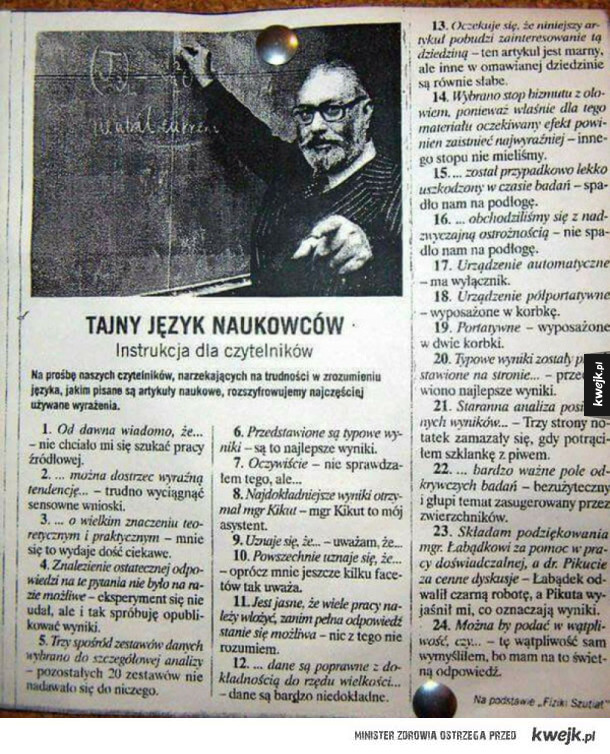forked from AITech/aitech-ium
13 KiB
13 KiB

Inżynieria uczenia maszynowego
12. Przygotowanie publikacji naukowej [laboratoria]
Tomasz Ziętkiewicz (2021)

Latex
- LaTeX (wym. _Latech) to system składu tekstu
- https://www.latex-project.org//
- Podejście WYSIWYM("What you see is what you mean") w przeciwieństwie do WYSIWIG (What you see is what you get).
- Piszemy tekst ze znacznikami, kompipujemy, dostajemy gotowy dokument, np. pdf
- Stosowany powszechnie do pisania publikacji naukowych na konferencje, do czasopism i książek
- Pozwala łatwo zmienić styl/szablon
- W założeniu, podczas pisania skupiamy się na treści i strukturze a LaTeX sam zatroszczy się o wygląd
- Przystępna dokumentacja: https://www.overleaf.com/learn/latex/Learn_LaTeX_in_30_minutes
Struktura
\documentclass[conference]{IEEEtran}
%\documentclass[a4paper]{IEEEconf}
\usepackage[]{graphicx}
% to typeset algorithms
\usepackage{algorithmic}
\usepackage{algorithm}
% to typeset code fragments
\usepackage{listings}
% to make an accent \k be available
\usepackage[OT4,T1]{fontenc}
% provides various features to facilitate writing math formulas and to improve the typographical quality of their output.
\usepackage[cmex10]{amsmath}
\interdisplaylinepenalty=2500
% por urls typesetting and breaking
\usepackage{url}
% for vertical merging table cells
\usepackage{multirow}
% \usepackage[utf8]{inputenc}
\title{Research paper structure in LaTeX}
%\author{}
\name{Tomasz Ziętkiewicz}
\begin{document}
\maketitle
%
\begin{abstract}
This paper is an example of a paper structure in \LaTeX
\end{abstract}
\noindent\textbf{Index Terms}: speech recognition, error correction, post-processing, post-editing, natural language processing
\section{Introduction}
Introductions has always been very important parts of scientific papers...
\section{Related work} \label{sec:related}
Tips on writing research papers can be found in \cite{howtowrite}
\section{Data} \label{sec:data}
Data is prepared using our novel data pipeline presented on figure \ref{fig:data-piepline}
\begin{figure}[htbp]
\centering
\label{fig:data-pipeline}
\includegraphics[scale=0.6]{data-pipeline.pdf}
\caption{Data preparation pipeline}
\end{figure}
Data statistics are shown in Table \ref{tab:data}.
Data sets were randomly divided into training, development, and test subsets in a proportion 8:1:1.
\begin{table}
\caption{Datasets statistics }
\label{tab:data}
\centering
\begin{tabular}{|l|r|r|r|r|r|}
\hline
Language & \textbf{de-DE} & \textbf{es-ES} & \textbf{fr-FR} \\\\
\hline
Sentences & $12 242$ & $16 905$ & $7180$ \\\\
Tokens & $37 955$ & $55 567$ & $28 004$ \\\\
\hline
\end{tabular}
\end{table}
\section{Method} \label{sec:method}
The proposed method consists of ...
\subsection{Data preparation}
To train the model, a lot of data is needed...
\subsection{Architecture}
\section{Results} \label{sec:results}
Table \ref{tab:results} presents averaged results.
The metric used is computes as follows:
\begin{equation}
RMSE = \sqrt{\frac{1}{n}\Sigma_{i=1}^{n}{\Big(\frac{d_i -f_i}{\sigma_i}\Big)^2}}
\end{equation}
where ...
\begin{table}
\begin{tabular}{|l|c|c|c|c|c|}
\hline
& Train & Test & Dev & - & Eval\\\\
\hline
Raw ASR 1best & 9.59 & 12.08 & 12.39 & 45.64 & 27.6\\\\
\hline
lattice oracle WER & 3.75 & 4.72 & 4.93 & 30.71 & 17.7\\\\
\hline
Edit operation tagger (from 1best) & - & 10.7 & - & - & 24.7\\\\
\hline
Absolute WER Reduction & - & $11.42\%$ & - & - & $10.50\%$ \\\\
\hline
Relative WER Reduction & - & $11.42\%$ & - & - & $10.50\%$ \\\\
\hline
\end{tabular}
\label{tab:results}
\caption{Word Error Rates for input data and the proposed system.}
\end{table}
\section{Conclusions} \label{sec:conclusions}
We presented a new approach to ASR errors correction problem. As demonstrated using three independent datasets, correction models trained using this approach are effective even for relatively small training datasets. The method allows to precisely control which errors should be included in the model and which of the included ones should be corrected at the inference time. The evaluations performed on the models show that they can significantly improve the ASR results by reducing the WER by more than $20\%$. All of the models presented offer very good inference latency, making them suitable for use with streaming ASR systems.
The presented method is well suited for industrial applications where the ability to precisely control how the error correction model works, as well as small latency, are crucial.
%\section{Acknowledgements}
\bibliographystyle{IEEEtran}
\bibliography{bibliography}
\end{document}
@book{Hastie2009,
title={The Elements of Statistical Learning: Data Mining, Inference, and Prediction},
author={Hastie, Trevor and Tibshirani, Robert and Friedman, Jerome},
year={2009},
publisher={Springer},
address = {New York, NY},
edition = {2nd}
}
@article{Byon2013,
title = {Wind turbine operations and maintenance: A tractable approximation of dynamic decision-making},
author = {Byon, E.},
journal = { IIE Transactions},
volume = {45},
number = {11},
pages = {1188--1201},
year = {2013}
}
@inproceedings{Breunig2000,
title={{LOF}: Identifying density-based local outliers},
author={Breunig, M. M. and Kriegel, H.-P. and Ng, R. T. and Sander, J.},
booktitle={Proceedings of the 2000 ACM SIGMOD International Conference on Management of Data},
pages={93--104},
year={2000},
organization={ACM}
}
@incollection{Yang2010,
author = "Yang, J. AND Huang, T. S.",
title = "Image super-resolution: {H}istorical overview and future challenges",
booktitle = "Super-Resolution Imaging",
editor = "Milanfar, Peyman",
pages ="3--35",
publisher = "Chapman \& Hall/CRC Press",
address = {Boca Raton, FL},
year = "2010"
}
Overleaf
- Overlaf to serwis/aplikacja webowa umożliwiająca edycję i kompilację dokumentów Latexa on-line, w przeglądarce
- https://www.overleaf.com/
- Działa od ręki, bez potrzeby konfiguracji, instalacji pakietów itp.
- podgląd gotowego dokumentu, automatyczna kompilacja
- edytor z uzupełnianiem składni
- intagracja z Git/GitHub
Części artykułu naukowego
- Abstract
- Introduction - "Dlaczego?"
- Related work - "Kontekst naukowy"
- Method - "Jak?"
- Results - "Co?"
- Conclusions/Discussion - "Interpretacja wyników"

Jak napisać artykuł naukowy z dziedziny ML:
- http://www.isle.org/~langley/papers/craft.ml2k.pdf / https://icml.cc/Conferences/2002/craft.html
- https://www.researchgate.net/publication/337857231_How_to_Write_a_Machine_Learning_Paper_for_not_so_Dummies/comments
- https://towardsdatascience.com/writing-more-successful-machine-learning-research-papers-39863ca9ea90
- https://towardsdatascience.com/tips-for-reading-and-writing-an-ml-research-paper-a505863055cf
- https://ekulczycki.pl/warsztat_badacza/struktura-artykulu-naukowego-uniwersalne-wytyczne-i-przydatne-wskazowki/
Zadanie
- Wybierz konferencję naukową z dziedziny ML/AI/Computer Science
- Używając szablonu Latex udostępnionego przez organizatorów konferencji, stwórz szkic artykułu naukowego opisującego wyniki eksperymentów ML, które przeprowadziłaś/eś w trakcie zajęć.
- Napisz artykuł używając Overleaf. Udostępnij w arkuszu z zapisami link udostępniający dokument (jak stworzyć taki link)
- Artykuł musi zawierać co najmniej:
- 6 niepustych sekcji (abstract, introduction, related work, method, results, conclusions)
- jedną tabelkę (np. opisującą dane lub wyniki)
- jedną ilustrację (np. jakiś wykres, który tworzyli Państwo na zajęciach)
- 5 cytowań (można np. zacytować artykuły opisujące użytą metodę, zbiory danych, narzędzia. Zazwyczaj popularne biblioteki, datasety podają w README jak należy je cytować)
- 1 wzór matematyczny
- Artykuł powinien być zgodny z wytycznymi konferencji dotyczącymi formy artykułów (oczywiście poza liczbą stron)
Zapewne w napisanym artykule nie opiszą państwo niczego nowatorskiego i wartego publikacji - tutaj udajemy, że zastosowaliśmy metodę po raz pierwszy, osiągnęliśmy nieosiągalne dotąd wyniki itp. Liczy się forma i struktura pracy. Można dodać komentarz wyjaśniający prawdziwy cel artykuły w sekcji/przypisie "Disclaimer", żeby nikt Państwa nie posądzał o pisanie nieprawdy.